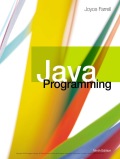
Explanation of Solution
Program code:
MadLib.java
//import the required packages
import java.io.*;
//define a class MadLib
class MadLib
{
//define a method intro()
private static void intro()
{
//create a string variable and initialize it
String msg = "This is a Mad-Lib game. I will prompt " +
"you for five words.\n";
//print the string
System.out.print(msg);
}
//define a method getInput()
private static String getInput(String msg) throws IOException
{
//create the object of BufferReader
BufferedReader stdin;
//initialize the object
stdin = new BufferedReader(new InputStreamReader(System.in));
//print the string msg
System.out.print(msg);
//return the line readed
return stdin.readLine();
}
//define a method printOutput
private static void printOutput (String noun1, String adverb, String noun2, String pronoun, String adj)
{
//create a string output and set the value
String output = "\nThree blind " + noun1 + ", \nThree blind " + noun1 + ", \nsee " + adverb +
" they run!" + "\nsee " + adverb + " they run!\nThey all ran after the farmer's " + noun2 +
"\nWho cut off their tails,\nWith a carving knife.\nDid you ever see " +
pronoun + " a thing in your life,\nAs three " + adj + " mice.";
//print output
System.out.println(output);
}
//define a main() method
public static void main(String[] args) throws IOException
{
//call the method intro()
intro();
//get the value for noun1
String noun1 = getInput("Enter a noun : ");
//get the value for adverb
String adverb = getInput("Enter a adverb : ");
//get the value for noun2
String noun2 = getInput("Enter a another noun : ");
//get the value for pronoun
String pronoun = getInput("Enter a pronoun : ");
//get the value for adj
String adj = getInput("Enter an adjective : ");
//print the accepted values
printOutput(noun1, adverb, noun2, pronoun, adj);
}
}
Explanation:
The above snippet of code is used get the noun, adverb, pronoun and adjective from the user and creates the sentences using it...
Trending nowThis is a popular solution!

Chapter 2 Solutions
EBK JAVA PROGRAMMING
- Dijkstra's Algorithm (part 1). Consider the network shown below, and Dijkstra’s link-state algorithm. Here, we are interested in computing the least cost path from node E (note: the start node here is E) to all other nodes using Dijkstra's algorithm. Using the algorithm statement used in the textbook and its visual representation, complete the "Step 0" row in the table below showing the link state algorithm’s execution by matching the table entries (i), (ii), (iii), and (iv) with their values. Write down your final [correct] answer, as you‘ll need it for the next question.arrow_forward4. |z + 5 - 5i| = 7arrow_forward14. dz, C: |z❘ C: |z❘ = 0.6 ze² - 2iz Harrow_forward
 EBK JAVA PROGRAMMINGComputer ScienceISBN:9781305480537Author:FARRELLPublisher:CENGAGE LEARNING - CONSIGNMENT
EBK JAVA PROGRAMMINGComputer ScienceISBN:9781305480537Author:FARRELLPublisher:CENGAGE LEARNING - CONSIGNMENT EBK JAVA PROGRAMMINGComputer ScienceISBN:9781337671385Author:FARRELLPublisher:CENGAGE LEARNING - CONSIGNMENTProgramming Logic & Design ComprehensiveComputer ScienceISBN:9781337669405Author:FARRELLPublisher:Cengage
EBK JAVA PROGRAMMINGComputer ScienceISBN:9781337671385Author:FARRELLPublisher:CENGAGE LEARNING - CONSIGNMENTProgramming Logic & Design ComprehensiveComputer ScienceISBN:9781337669405Author:FARRELLPublisher:Cengage Microsoft Visual C#Computer ScienceISBN:9781337102100Author:Joyce, Farrell.Publisher:Cengage Learning,
Microsoft Visual C#Computer ScienceISBN:9781337102100Author:Joyce, Farrell.Publisher:Cengage Learning, Principles of Information Systems (MindTap Course...Computer ScienceISBN:9781285867168Author:Ralph Stair, George ReynoldsPublisher:Cengage Learning
Principles of Information Systems (MindTap Course...Computer ScienceISBN:9781285867168Author:Ralph Stair, George ReynoldsPublisher:Cengage Learning Systems ArchitectureComputer ScienceISBN:9781305080195Author:Stephen D. BurdPublisher:Cengage Learning
Systems ArchitectureComputer ScienceISBN:9781305080195Author:Stephen D. BurdPublisher:Cengage Learning





